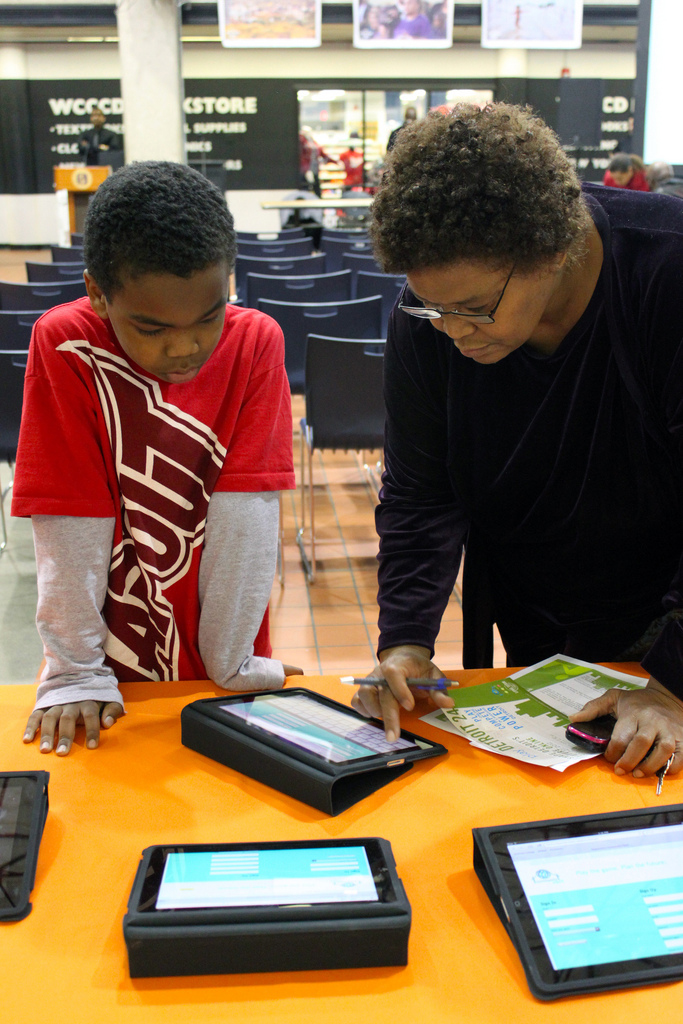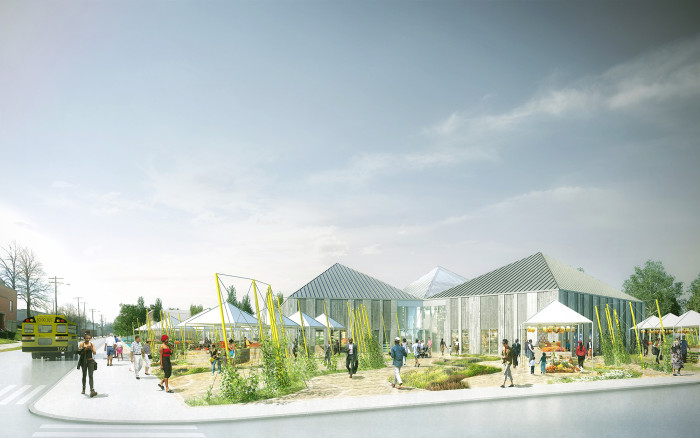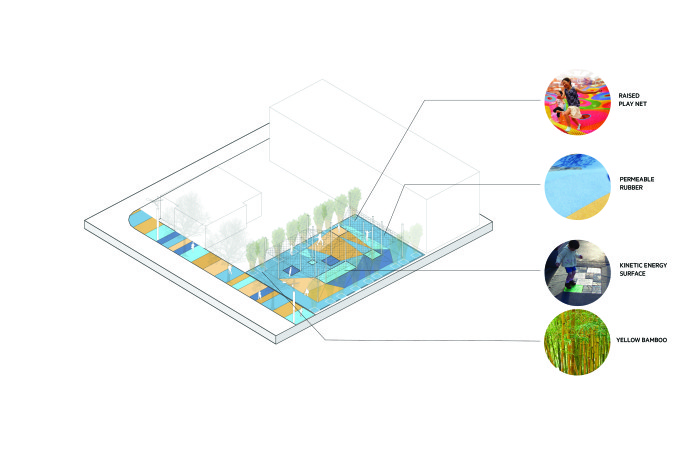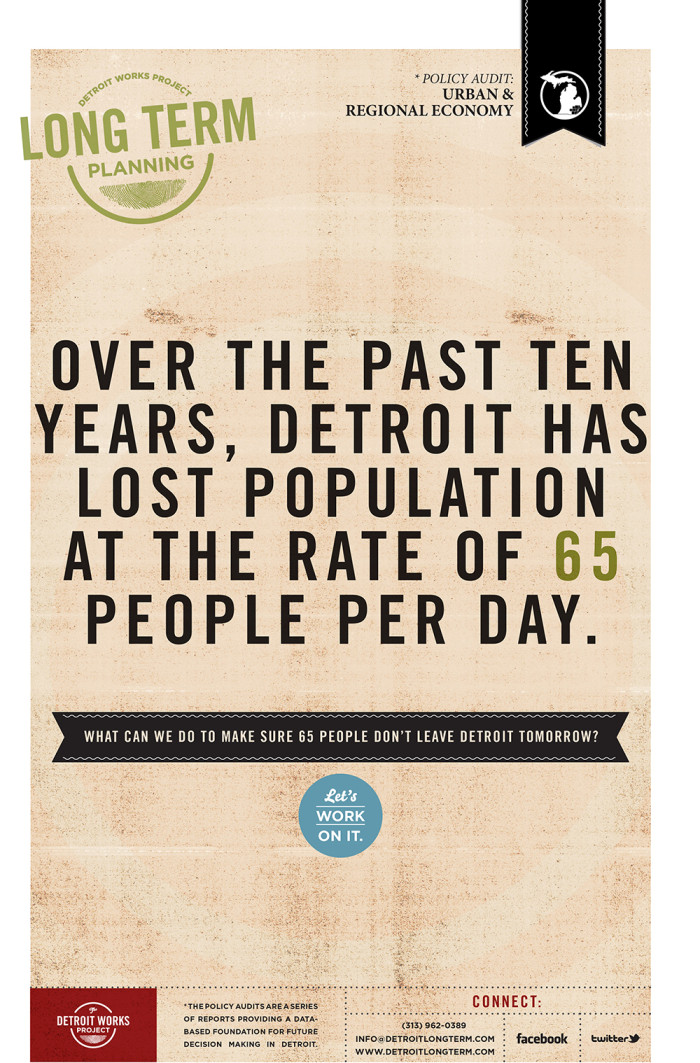
Part of the Detroit Future City citywide planning effort, the Detroit 24/7 online Community PlanIt game was designed to engage a younger demographic—42% of players were in their teens—over 1,000 players registered generating more than 8,000 comments about their own experience with Detroit and its future. Community leader Denise Kennedy and her grandson register for the game.
Cynthia E. Smith talks with Toni L. Griffin and Chris Reed about their recent projects and how design can respond to social and spatial injustices. Griffin and Reed collaborated on the Detroit Future City Strategic Framework—an innovative, twenty-first-century planning model for urban revitalization. The project is one of sixty that Smith has included in By the People: Designing a Better America, a Cooper Hewitt exhibition open now through February 26, 2017.
Toni L. Griffin is Founder, Urban Planning for the American City, and Professor in Practice, Harvard Graduate School of Design. Chris Reed is Principal, Stoss Landscape Urbanism, and Associate Professor in Practice of Landscape Architecture, Harvard Graduate School of Design. Cynthia E. Smith is Curator of Socially Responsible Design, Cooper Hewitt.
Cynthia: Toni, you have been asking your students what makes a just city. How do you answer this important question?
Toni: This has been a question I’ve been thinking about for the last five years. How do people who have been marginalized in urban neighborhoods and cities gain equitable, inclusive access and the opportunity to live productive lives in safe, beautiful, and flexible environments? Critical to that ambition is having a strong sense of inclusion and belonging. We are seeing a lot of civil unrest in public space that is surfacing peoples’ fears and anxieties around being included and feeling a sense of belonging in cities. Ownership is becoming very important to me as well. As we continue to debate the pros and cons of neighborhood change and gentrification, the sense of ownership in decision making or processes of decision making, as well as ownership of material goods like property and income, are very important for ensuring more inclusion and equity in neighborhoods.

Community garden and farmer’s market at the West Louisville Food Port, Louisville, KY.
Cynthia: And these are in addition to a whole set of metrics that you’ve put together prior to this, the Just City Indicator Metrics?
Toni: The Just City project is a couple of things. First, it has created a platform through social media and published essays for defining and discussing the just city, and is beginning to suggest that the role design plays in addressing issues of injustice in cities and neighborhoods actually must go beyond only seeking to achieve equity. Second, we are developing a framework of metrics aligned with different social justice values to understand how the work we do as designers and planners has a positive impact on making changes to injustice. Work from the Just City Lab can be found at designforthejustcity.org.
Cynthia: Chris, Stoss describes its work as “landscape urbanism.” How is this emerging area different from landscape architecture, and why now?
Chris: You can look at landscape urbanism in three ways. First, landscape urbanism takes on the idea of urban and metropolitan landscapes as multifunctional and productive, that they can absorb the roles of traditional infra- structure (stormwater collection, flood control, environmental remediation) like many nineteenth-century urban park systems in America. Second, think about landscape urbanism as a bigger idea about how landscape systems can structure entire urban districts or metropolitan regions, whether these places are rapidly expanding or have shrunk in size like Detroit. And third, think of landscape urbanism as a more theoretical investigation into the operational aspects of landscape: how can landscape begin to play a bigger role in the way that cities are made, or remade, and function better over time? We’re confronting fairly serious issues stemming from climate change—food shortages, drought, and flooding—and we are seeing heightened differences among the ways that people live. Whether it’s in older, postindustrial cities or newer emerging cities, we see a lot of different forms of social and environmental injustices, and landscapes of many types can help to address these challenges.
Cynthia: You have each worked in different cities around the country and recently together on the Detroit Future City Strategic Framework. From each of your vantage points, what role can design play in addressing systemic injustices in U.S. cities? Do you have any cautionary tales?
Chris: I think it can play roles in different ways. If we start with project examples, we might be able to extrapolate bigger principles. Three projects that come to mind that Stoss has been working on are, first, Movement on Main, a design competition organized in a neighborhood in Syracuse, New York, that’s suffered population loss, lower incomes, and unemployment. It asked the questions: How do you rethink the role of the street in the life of the neighborhood? What role can landscape play not only in the reshaping of the image and the function of the place, but also in helping contribute to improving the neighborhood’s overall declining public health? Second, a midsize project of a much different kind based in the Pittsburgh neighborhood of Atlanta— a former industrial site next to the Atlanta Beltline. This project looked at how to develop the site in a way that’s relevant for the current neighborhood as well as bringing in new and future economic opportunities fostering the longer term. The third project we’re involved in is called the West Louisville FoodPort in West Louisville, Kentucky—an economically depressed area of the city that historically suffered through polluting industries—where a lot of minorities live. On the one hand, we’re doing cleanup, so we’re providing a kind of environmental service. But the project itself is all about healthy food and healthy eating—building a facility that’s going to process, distribute, grow, and provide entrepreneurial opportunities, education, and demonstrations.
Toni: In my work as an urban planner, the injustices I constantly confront center on concentrated poverty, conditions of disinvestment and abandonment, and socioeconomic division. Embedded in these injustices is the need for both spatial and social applications. So my work in the urban planning and the design of spaces looks to reconcile both elements that are completely interconnected. The cautionary tale is to acknowledge that many conditions of injustice have actually been created at the hand of design and policy practices, like federal highway policies and urban renewal that once obliterated black inner-city communities. The collaboration with Stoss was essential for looking at landscape in multifunctional ways, as Chris described. Design as active intervention was key to re-imagining neighborhoods so they could produce higher qualities of life. We designed an elaborate engagement process that was inclusive across all sectors of the Detroit community, identifying what their actual aspirations were going forward. As a result, we engaged nearly a fifth of Detroit’s population through our efforts, and as a result of that, a diverse set of actors across business, civic, community, nonprofit, and government sectors are playing active in implementing the change that we proposed.

Wyoming Street Playground, part of the Movement on Main initiative in Syracuse New York’s Near Westside.
Cynthia: How do you begin to work with communities to determine their set of values so they can make planning and design decisions at the neighborhood and city scale? And how do you go about working directly with communities to either facilitate changes or inform your design?
Toni: For me, having practiced both as a private-sector consultant and as a public official, it’s in thinking about how to actually set the table for implementation of a plan. I think both Chris and I would agree, the last thing we want to do is just design something that won’t get executed.
Chris: That’s correct.
Toni: With that in mind, it is imperative that multiple community actors be involved and participate in designing and implementing the change. Government doesn’t execute neighborhood change by itself. Government has a set of tools that it can put on the table, as do the private and community sectors—and it’s important that all work collaboratively. The time and effort that you take to do that up front always yield more productive results in the end. The other essential point is not to design to a universal standard. Certain communities have practices, traditions, and aesthetics that we have to begin to validate as a legitimate informant. Understanding authentic, place-based, and contextual elements can lead to more innovation in our work and more ownership and sustainability of a project.
Chris: The engagement that we do individually and collectively has to be deep and interactive. We try to find venues, forums, and techniques where we engage people in ways that allow them to interact with us in a more relaxed, interpersonal way. We try to set up environments that break down differences and establish trust. How do you engage kids and younger people? Games or exercises that allow them to express preferences, concerns—those sorts of things. Food is a great way to just get people around the table talking about what’s possible in the environment.

The broad-based Detroit Future City civic engagement was designed to let the community have a say in Detroit’s future. Twenty-six interactive tactics were devised to engage a diverse range of participants, including posters that were hung throughout the city exposing assets and startling statistics about the area.
Cynthia: You are both practitioners and teachers. What are the most important skills young designers should acquire during their studies?
Chris: In landscape architecture, it’s important to understand the wide range of issues that might come into play in a project, including climate environmental, urban, and ecological issues, and the historical social injustices of the past.
Toni: I would agree with all of that, even from the perspective of urban planning. The challenges that I think our students will face—particularly as they go to work in urban environments—are cross-disciplinary, interconnected problems that have been created not by one discipline, but by a layering of different disciplines, conditions, and policies. Thinking about both spatial and social justice issues, for example, is critically important to the urban design or planning student today.
This interview is excerpted from the Cooper Hewitt’s Spring 2016 Design Journal, available to Cooper Hewitt members.